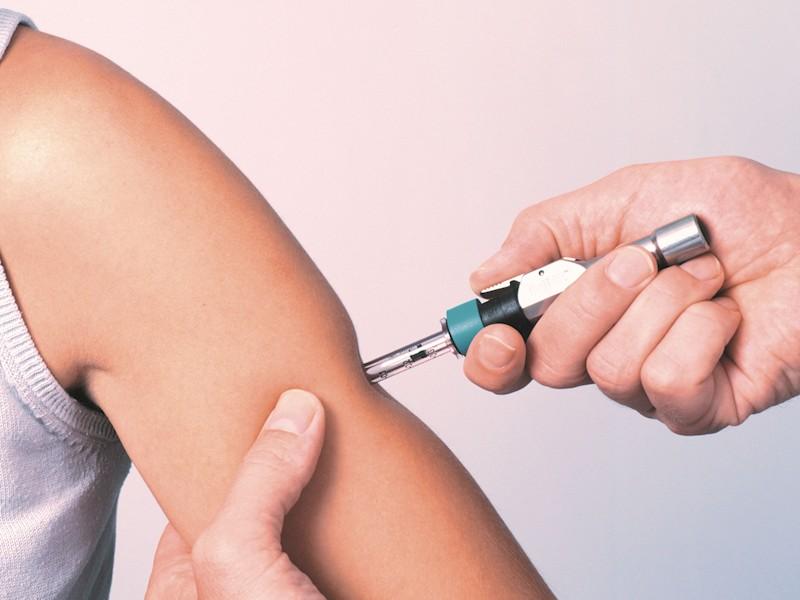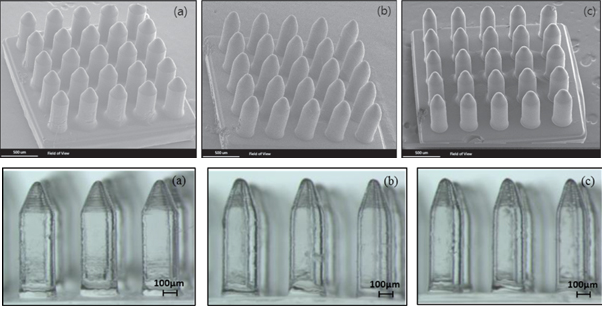
As 3D printing technology is suddenly the catalyst for changing so many inconvenient–and sometimes miserable–processes, certainly it should be able to take away something as simple as the world of painful injections, right? Soon, friends, soon.
According to researchers based at the University of Akron and the University of Texas, they have been working on a method few of us probably expected. Projecting that it will be released in the next five to six years, this new pain-free injection method involves inserting of a 3D printed device directly into the body where it diffuses drugs and then biodegrades within. Meant for a wide range of uses, this new method and 3D printed device could offer more streamlined efficiency of drug delivery for chemotherapy in treating cancers like melanoma, using Dacarbazine.
The devices are micro-needles 3D printed using microstereolithography. Offering a pain-free alternative, the testing arrays so far have been made up of 25 poly(propylene fumarate) micro-needles, with each needle having a tip and base diameter of 20 micrometers and 200 micrometers respectively, with a height of 1 millimeter.
“3D printing this array was difficult, as the printable biomaterial contains some non-printable solvents and drugs,” said Jae-Won Choi, an author on the research paper published in the journal Biofabrication.
According to the paper, ‘Microstereolithography and characterization of poly(propylene fumarate)-based drug-loaded microneedle arrays,’ the researchers found that not only were they able to eliminate pain, but they were able to increase the effectiveness of drugs as they were strategically released into the body, targeting required areas.
“We’d like to have a faster drug release, but this will require more material research. Once we improve this process we can look at developing more controlled drug release,” Choi said.
In this amazing new process, the needles, integrated inside the skin, were flexible and durable enough to withstand the new technique which is much more beneficial than traditional techniques which can cause significant side effects, and even infection.
“With the developed system, high-aspect ratio microneedles can be fabricated in micrometer range. Dacarbazine was loaded into PPF matrices and the microneedle arrays were fabricated using a projection μSL system,” stated the researchers in their paper. “With this method, microneedles of a controlled length should penetrate into the dermis with minimal disruption of the nerves endings. And the encapsulated drug would be released from the drug-loaded PPF matrices. The release rate can be controlled by altering the drug loading and the molecular weight of the PPF monomer. Compressive testing of single microneedle demonstrated that the resulting transdermal device should penetrate the skin without structural failure.”
Extensive testing was performed by the researchers, who designed the microneedles using SOLIDWORKS. In a five-week study using the 3D printed needles, researchers used micro-needle arrays containing 1% and 2% dacarbazine.
“The single microneedle compression results indicated that the microneedles had high mechanical strengths and that the failure forces were much higher than the calculated insertion force. Finally, the drug release kinetics was obtained through a drug release test for 5 weeks,” stated the researchers. “The amount of the drug released could be altered by increasing the loading, but changing the molecular weight of PPF is needed to alter the release profile. These results show that μSL could be a valuable technique to fabricate the drug release devices that require high structural stabilities.”
While the study certainly had positive results for treating skin cancer with dacarbazine, this technology opens up the door for using the same methods in a variety of biomedical applications. Certainly it’s just the beginning for delving into using 3D printing technology for making new and innovative devices that can take the pain out of many other procedures as well.
What are your thoughts on this new needle and what it may mean for the medical industry? Discuss in the 3D Printed Micro-needle forum thread on 3DPB.com.
“Microstereolithography and characterization of poly(propylene fumarate)-based drug-loaded microneedle arrays,” by Yanfeng Lu, Satya Nymisha Mantha, Douglas C Crowder, Sofia Chinchilla, Kush N Shah,Yang H Yun, Ryan B Wicker and Jae-Won Choi, was published September 30, 2015 in Biofabrication, Volume Seven, Number Four.
[Source: News Nation | Images Sourced from Biofabrication]